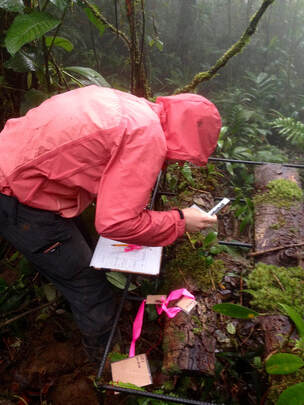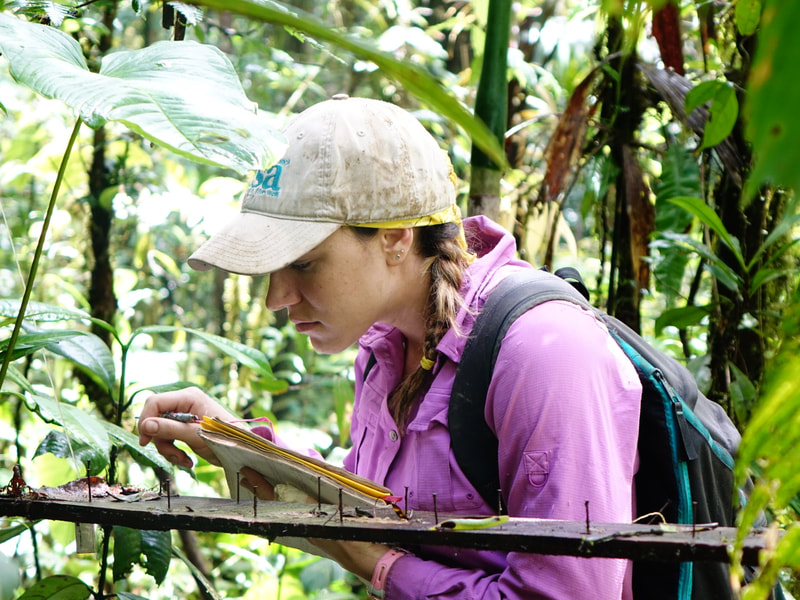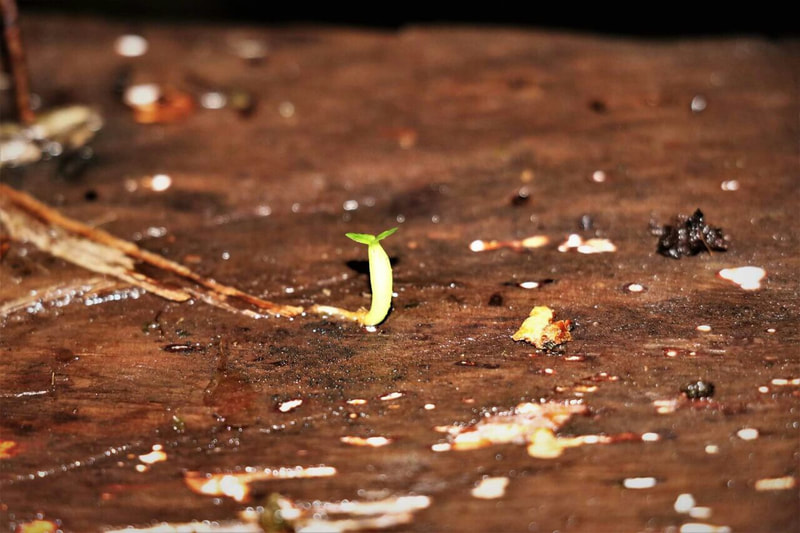Canopy ecology:
An opportunity to test community assembly theory in 3D space
|
Epiphytes are a unique plant growth-form that live non-parasitically on other plants and constitute approximately one fifth of Neotropical vascular plant diversity. They mediate ecosystem funtion, host a wide array of specialist insects and provide habitat for rare amphibians and birds. Despite their clear ecological importance, much of the basic community ecology of epiphytes remains unknown. I recently set up two long-term epiphyte field experiment to test various hypotheses of how diverse epiphyte communities assemble and develop. See project summaries below for details.
|
Substrate texture and removal processes in the early life of epiphytes
 Experimental design testing how substrate texture affects epiphyte germination.
Experimental design testing how substrate texture affects epiphyte germination.
Although epiphytes make vital contributions to tropical forest structure and function, the mechanisms governing epiphyte community assembly are poorly understood. The properties of substrates are likely critical to the establishment of diverse epiphyte communities, because of the inherently close connection between an epiphyte and its host tree. However, little experimental evidence exists for when during ontogeny that host traits are most important, or what host traits drive epiphyte community development. Here, we use an in situ experiment in the cloud forest of Santa Fé, Panama to test the extent to which substrate texture serves as a filter to epiphyte establishment. We experimentally varied the rugosity (roughness) of substrates derived from a native tree species, applied a mix of various epiphyte seeds to the substrates, and monitored seed germination and establishment over several months. We present some of the first experimental field evidence that substrate texture mediates epiphyte establishment. Rougher substrates facilitated higher epiphyte establishment, and epiphyte seedling abundances differed between the smoothest and the two substrates with the highest rugosity. After just two months, less than 1% of all seedlings on average were present on the smoothest substrate while 34% of the seedlings remained on the second-roughest substrate. Epiphyte cohort survival rates differed among rugosity treatments, but nearly all germinated seedlings died after approximately one year. Our results suggest that the texture of the substrate can account for some of the variability in epiphyte seedling survival at this early bottleneck stage.
Project publication: Spicer ME, Ortega J, & Carson WP. “Substrate texture mediates vascular epiphyte establishment: experimental evidence from a Panamanian cloud forest.” In final revisions at Journal of Tropical Ecology.
Project presentation: Spicer ME & Carson WP. “Substrate texture mediates vascular epiphyte establishment: Experimental evidence from a Panamanian cloud forest.” Ecological Society of America Annual Meeting, Louisville, KT. 13 Aug 2019.
Project presentation: Spicer ME & Carson WP. “Substrate texture mediates vascular epiphyte establishment: Experimental evidence from a Panamanian cloud forest.” Ecological Society of America Annual Meeting, Louisville, KT. 13 Aug 2019.
Epiphyte mortality: vertical niche differentiation or contact with the ground?

Epiphytes are characterized by their structural dependence on other plants to persist high in the forest profile and by their ability to survive without a root connection to the ground. Although epiphytes make up approximately one-fifth of tropical vascular plant diversity, the life-history and ecological trade-offs of this unique aerial growth habit remain largely untested experimentally. Mortality due to falling from the host tree has recently been raised as an underappreciated driver of epiphyte community dynamics. Mortality rates of fallen epiphytes generally exceed 70%, but little empirical evidence exists for why epiphytes do not survive when forced to become terrestrial. Moreover, the variation in mortality rates of fallen epiphytes among taxonomic groups, and among epiphytes which reside in the same vertical strata, remains relatively unexplored. Here, we experimentally test two hypotheses regarding the drivers of epiphyte mortality in a cloud forest of central Panama. We test whether simple contact with terrestrial soil is deleterious to epiphytes, preliminarily testing the Epiphyte Enemy Escape Hypothesis. We also test the Vertical Niche Differentiation Hypothesis, wherein epiphytes are specifically adapted for microsites throughout the vertical forest strata. By monitoring leaf loss, health status, and mortality of 270 transplanted epiphytes for nine months, we pinpoint the extent to which distance from the ground regulates epiphyte mortality. We found support for both of our hypotheses. After nine months, leaf abundance was 40% lower in epiphytes that were in contact with the ground in comparison to those transplanted just above the ground. Likewise, epiphytes in contact with the ground had a 26% lower survival rate versus epiphytes transplanted a few meters higher. Mortality rates were also mediated by original height where the epiphyte occurred in the host tree prior to transplanting. Our results demonstrate that contact with the terrestrial soil regulates early fallen epiphyte mortality, and epiphytes that occur high in the canopy are particularly vulnerable to mortality via falling. These results have important implications both for fundamental ecological theory and for biodiversity conservation management. Follow-up studies should explore the role of terrestrial soil microbes as potential drivers of decreased grounded epiphyte survival. Moreover, the high success and survival rate of epiphytes transplanted above the soil surface highlight an overlooked management technique: moving fallen epiphytes to nearby trees could help increase establishment or population stability of epiphyte communities. This would be particularly useful in relatively epiphyte-poor secondary forests and small forest fragments.
Project presentation:
Spicer ME, Ortega, JA, & Carson WP. “If an epiphyte falls in the forest, why does it die? Experimentally testing drivers of vascular epiphyte mortality.” SACNAS: The National Diversity in STEM Conference (Virtual). 19-24 Oct 2020.
Project presentation:
Spicer ME, Ortega, JA, & Carson WP. “If an epiphyte falls in the forest, why does it die? Experimentally testing drivers of vascular epiphyte mortality.” SACNAS: The National Diversity in STEM Conference (Virtual). 19-24 Oct 2020.





